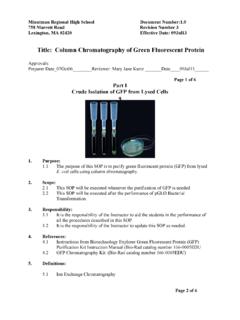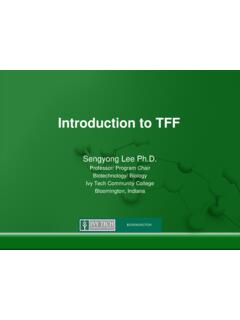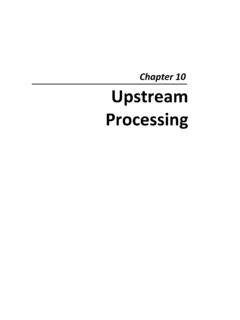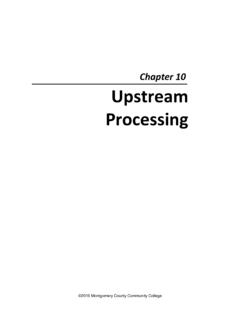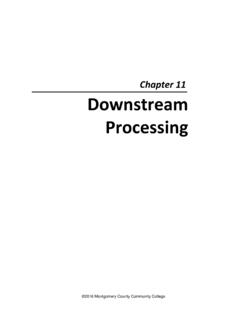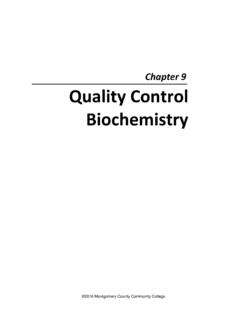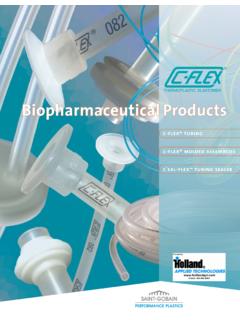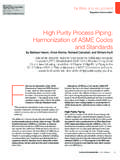Transcription of Overview Development and Manufacturing of Injectable ...
1 Overview Development and Manufacturing of Injectable ( parenteral ). drug Products Unit Development and Manufacturing of Injectable ( parenteral ) drug Products From discovering the active ingredient to Manufacturing the finished product, the production of a drug is a complex, time consuming, and expensive process. There are many factors that must be considered during the process, including: determining the dose determining the route of administration determining what to mix with the drug (excipients) to stabilize the product determining how the drug is absorbed and excreted (pharmacokinetics). determining possible side effects determining whether the drug is stable as a solution or needs to be freeze-dried (lyophilized). identifying the correct vial and stopper use determining the manner in which the drug behaves/interacts during Manufacturing determining the proper filter and filtration techniques determining the proper protocol for labeling, packaging, and storing the drug ensuring the drug product is free of microorganisms, pyrogens, and foreign particulate matter The administration of drugs to humans through injection was first recorded as early as the mid- 1800s; however, little was known about microorganisms at the time, so safely administering an Injectable drug did not become a viable process until the early 1900s, when knowledge of microorganisms and sterilization techniques became more common.
2 During the early years sterilization techniques were limited to either heat sterilization or steam sterilization (autoclaving). These techniques were extremely damaging to drug products, and it was not until the advent of HEPA filters, clean rooms, and sterilizing filters that aseptic Manufacturing became a more common practice for producing aseptic drugs without heating the drug product directly all of the components were pre-sterilized then brought together in a sterile environment. Types of Injectable drug Products Injectable drug products can be developed into several different types depending upon the characteristics of the drug , the desired onset of action of the drug , and the desired route of administration. The following presentations are typically used: Injectable solution: a drug dissolved in water (or other solvent) that may include additives, known as excipients, to help stabilize it Injectable suspension: drug crystals are not soluble in water, so the surface of the crystals are wetted to prevent them from floating on the solution surface; this is 2 Development and Manufacturing of parenteral drug Products Unit Overview typically accomplished using a surfactant; suspending agents are then added to prevent the crystals from settling to the bottom and forming a solid (concretion), which is difficult to re-suspend.
3 Injectable emulsion: a drug that is not soluble in water so it is dissolved in an oil, which is then added to water with an emulsifying agent; this is then mixed with a high shear mixer to reduce the oil droplets to micron-sized drops which remain in drops due to the emulsifying agent (surfactant). Pre-Formulation and Formulation Development There is a significant amount of time, effort, and expense required when identifying a new drug molecule, whether it is a small molecule or a large bio-molecule. However, once the molecule is identified and a process to mass produce the molecule is created, the final product Development work begins. The initial goal is to get the product to a semi-formulated state so it can be administered to animals for safety/toxicology studies (pre-clinical). For the early phases of animal and human studies (clinical trials) it is common to use drug products that are not in the final formulated state, as they need to be stable only through the course of the trial.
4 While these early phase studies are conducted, Development scientists work to identify the final formulation that will offer the best stability, safety, and efficacy. Pre-Formulation studies may include: pH stability pH solubility identifying a stability indicating analytical method thermal stability oxidation potential light stability hydrolysis potential Formulation studies may include: identifying both the need for and appropriate strength of a buffer system to control pH. identifying both the need for and appropriate strength of a surfactant identifying both the need for and appropriate strength of a stabilizer identifying both the need for and appropriate strength of a bulking agent identifying both the need for and appropriate strength of a solubilizing agent identifying both the need for and appropriate strength of a preservative system accelerated stability studies Introduction to Biomanufacturing 3. Process Compatibility Once the pre-formulation and formulation studies have identified a suitable drug product candidate, the next step includes learning how the formulation behaves/interacts in an aseptic Manufacturing facility.
5 Studies are conducted in order to understand the manner in which the product reacts when the formulated product comes into contact with different materials utilized during Manufacturing , including: glass stainless steel process tubing plastics other components that may come into contact with the drug product Product hold time studies are also conducted to determine the amount of time the product can sit in the filling vessel before it degrades or settles. Filtration At this point in the Manufacturing process the formulated drug product enters the Class A clean room. It remains under these conditions until the product is filled, stoppered, and capped. Only then does the product exit the clean room, unless it is destined to be freeze-dried, at which point the product is aseptically transported to the freeze-dryer. There are four primary types of filters used in the parenteral and biopharmaceutical industry (the type of filter chosen depends on the type of material to be removed).
6 The filter types include: clarifying filters large particles microfilter bacteria and yeasts (used for Injectable drug products). ultrafilter viruses nanofilter small organic compounds and ions The Injectable drug industry uses microfilters to remove particles in the to 10 micron size range from the formulated drug product. Several different types of membranes are available in this pore size range to accommodate different types of formulations, including water based formulations (hydrophilic) and solvent based formulations (hydrophobic). It is up to the Development scientist to conduct studies for filter compatibility in order to determine the correct filter and filter surface area for the particular product. For most parenteral products, a hydrophilic (water loving) filter is used and may include: cellulose acetate cellulose nitrate regenerated cellulose 4 Development and Manufacturing of parenteral drug Products Unit Overview modified regenerated cellulose polyamide (nylon).
7 Polycarbonate polyethersulfone polysulfone polyvinylidene difluoride (PVDF). The next step in the process is to sterilize the solution using one of the filters listed above. Note that products that are either suspensions or large particle-sized emulsions cannot be sterile filtered and have to be aseptically formulated all components are pre-sterilized individually and then brought together in a sterile environment. The filters are available as either flat disks or as cartridge filters, which significantly increase the filter surface area when extremely large volumes need to be filtered. To ensure that the filter membrane is completely intact (no holes), integrity testing must be performed both before and after filtering the product. This is accomplished through a process known as bubble point testing, a non-destructive integrity test measuring diffusive flow or water intrustion over the filter membrane. Filling Once the product has been filtered into a sterile filling container and the filter passes the post- fill integrity test, it is now ready to fill into its primary container.
8 Sterile tubing is placed into the sterile solution, which leads first to pumps and then to filling needles. There are several different pumps that can be used to fill the product, and the type of pump used depends upon the type of product being filled. The types of pumps include: gravity (solids and liquids). piston (liquids and gases). peristaltic (liquids and gases). The product is generally filled into glass vials; however, different types of containers can be filled depending on the product. Product can be filled into these containers using one of three main methods: volumetric a fixed volume is added time/pressure a fixed pressure is administered over a certain amount of time net weight each container is weighed while being filled Vials that have been pre-sterilized travel down the filling line and stop below the filling needles. The needles descend into the vials and slowly rise as the required amount of product is dispensed. This method of filling minimizes splashing of product on the sides of the container.
9 In special circumstances, where emulsions or suspensions are being filled, these products must be constantly recirculated to prevent settling of the solids at the bottom of the filling container. The weight of the vials must be initially checked after filling to ensure the proper dose is being Introduction to Biomanufacturing 5. dispensed; it should also be checked periodically throughout the run to ensure nothing has changed with the filling equipment that would cause either a low or high product fill. Stoppering Once the vials have been filled, they travel down the filling line to have pre-sterilized stoppers inserted. If the product is not scheduled to be freeze-dried, a stopper is fully inserted into the neck of the vial and the vial is transported to the capping station. If the product is going to be freeze-dried, a special stopper with a vapor port is partially inserted into the neck of the vial. The freeze-drying process, described in more detail below, allows for the removal of water; the ice created during the freezing phase of the process is converted to water vapor, which leaves the product via the open port in the specialized lyophilization stopper.
10 The difference between a standard serum stopper and a lyophilization stopper is illustrated in Figure 1. Figure 1. (L R) Standard serum and lyophilization stoppers 6 Development and Manufacturing of parenteral drug Products Unit Overview Capping If the vials are not scheduled to be freeze-dried they travel down the filling line to the capping station. Caps are used to secure the stopper in the neck of the vial to prevent the stopper from coming out either over time or during handling. The caps are comprised of a plastic cap and an aluminum skirt (Figure 2). Figure 2. Aluminum crimp caps The caps are fed down a chute to the vials as the vials travel down the filling line. One cap is loosely placed on the top of each vial. The vials then travel to the crimping station where rotating blades crimp the bottom of the aluminum skirt around a lip on the neck of the vial, producing a tight fit that locks the stopper into the neck of the vial. At the time of use the plastic cap is removed; this exposes the top of the stopper, which is then pierced with a needle to remove the contents inside the vial.
